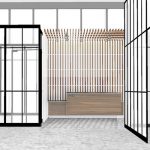A high-tech Office, Plant, and Warehouse Complex for state-of-the-art PVC/FRP manufacturing. The design explores emblematic features of this building type to create a bold and distinctive edifice, while appropriately resolving its programme. The plant involves complex process manufacturing design, with extensive structural, mechanical, electrical, and environmental criteria. (Winner of the Mississauga Urban Design Award)
The 6.5 acre site lies in a heavy industrial zone, which, not benefiting from a design-controlled industrial park, is subject to provide sector exigencies, producing a hard, amorphous landscape delimited by the horizon, spatially measured out by vehicle in roadways, superblocks and undifferentiable , standalone strucures.
To succeed in a milieu devoid of, for example, precise urban space, the site development from landscape to building detail must communicate in a clear, bold manner. This corner site is defined along the roadway by a “greenbelt”: a curving line of red maples planted at 50 foot spacing into a continuous wide band of lawn.
The three-component building is axial, and hierarchical in scale, material and detailing. The low, transparent office block presents itself to the street as the public-orientated element with two entries signaled by recessed, coloured planes; the plant, a silver rectagon, with a supertruss clerestory supported at its ends on triangular piers of ceramic tile, provides a backdrop to the office and screen for the rear outdoor storage; the third axial component, the warehouse, is a royal blue rectagon punctuated by colour-coded window frames, mandoors and truckdoors(southfacing for climatic reasons). The intent is to create a building of simple massing to suit the programme, superimposed with a layer of bold, coloured details which are meant to be emblematic, as a flag or corporate logo.
On another reading, the building is anthropomorphic, if the 60 foot long trucks attached to the building are the “legs” on which the products(rigo,company) travel, if the warehouse is the “stomach” in which the products reside before leaving, if the plant is the “upper torso” or primary action centre, if the office is the “head” or intelligence component, and if the planting around the office is the “hair”.
The “Orders” produced by the landscaping, the axiality, the hierarchy, the emblematic and anthropomorphic qualities clarify the component masses, the building and site functions, the circulation and entries, while rationally responding to the site and contributing a unique place within the industrial context of Mississauga.









